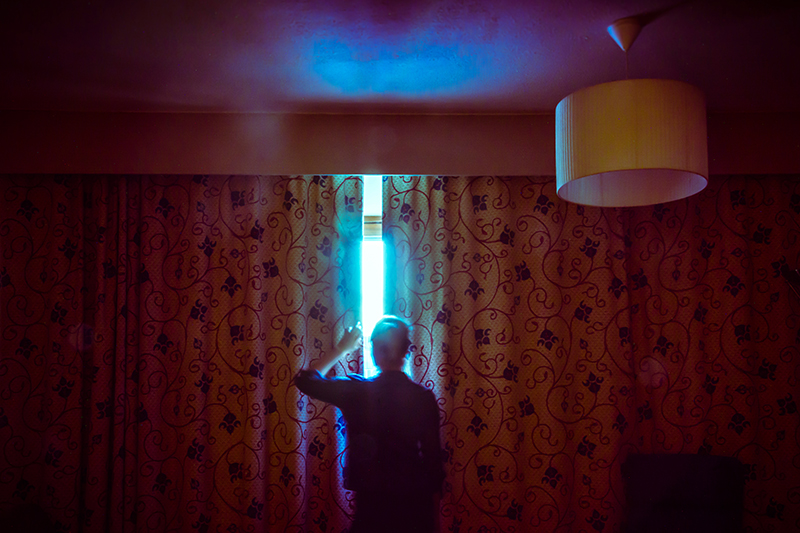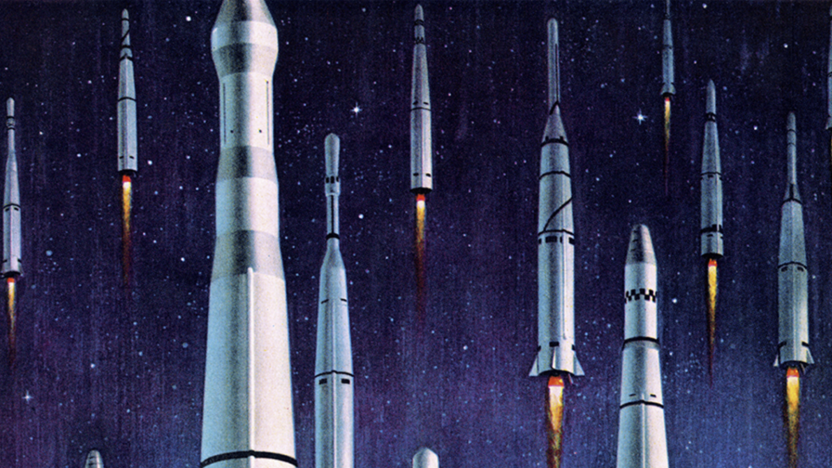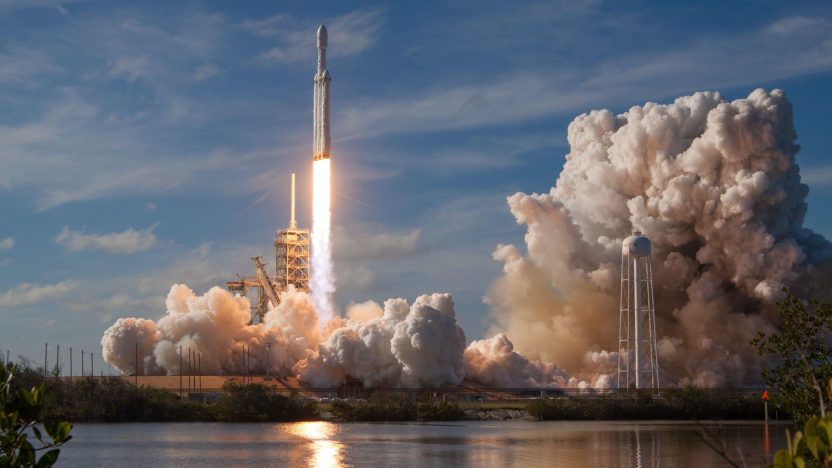Call of the outer wild
Whereas for the time being deep space is inaccessible, some people believe that aliens are out there waiting for us.
by Andrea Dusio

Let’s admit it, Stephen Hawking left us with a bit of suspense. A few months before he passed away, the famous cosmologist presented a documentary showing a computer-generated rendering of the environment of Gliese 832c, the extrasolar planet most similar to Earth, 16 light-years away. Hawking had joined the Breakthrough Listen project, funded with 100 million dollars by the Russian-Israeli billionaire Yuri Milner, designed to seek signs of life by observing millions of stars. “As I grow older, I am more convinced than ever that we are not alone. After a lifetime of wondering, I am helping to lead a new global effort to find out. One day we might receive a signal from a planet like Gliese 832c,” the scientist explained, “but we should be wary of answering back. They may not see us as any more valuable than we see bacteria.”
So should we turn down the last possible call of the wild and ignore the aliens? The quest for life forms on exoplanets has just begun. Until about thirty years ago, even the idea of reliably identifying a celestial body outside our solar system was particularly challenging. We knew there were millions of stars but weren’t at all sure whether any planetary systems were revolving around them. In 2019, two Swiss astronomers won the Nobel Prize precisely for discovering the first exoplanet orbiting a sun-like star. To date, we know of 4,375 extrasolar planets, in 3,465 different systems, 771 of which are multiples. Most of them were not identified using telescopes but rather through indirect observation, and the first confirmation of the actual existence of an exoplanet came in 1995. Exoplanet detection mainly relies on the radial-velocity method: significant shifts in a star’s spectrum reveal variations in its velocity relative to the Earth that suggest imbalances due to unseen exoplanets orbiting the star. In short, finding planets outside our solar system is complex, and even when we come across a new discovery, it is primarily gaseous clusters. Rocky bodies are rarer, and those with characteristics compatible with life are quite out of reach. Fortunately, Hawking thought.
“One day we might receive a signal from a planet like Gliese 832c, but we should be wary of answering back. They may not see us as any more valuable than we see bacteria.”
Meanwhile, for decades we have seen cases that suggest the existence of extraterrestrial life even at bus stops. Whereas for the time being, deep space is inaccessible, some people believe that aliens are out there waiting for us early in the morning when we leave home.
Back in 1988, a high-school friend of mine received an invitation to a conference in Milan, held by the magazine Non siamo soli. So we bought jackets and shirts, printed some business cards as reporters of a non-existent magazine we called Prospettive, and prepared to spend a Saturday among the followers of a former customs agent from Catania, Eugenio Siragusa, probably the best-known Italian “contactee.” This man had recounted numerous one-on-ones with aliens. On 25 March 1952, on his way to work early in the morning of his thirty-third birthday, he had seen a bright star approaching while waiting for a bus on the promenade. It grew to become about four times the size of the moon. Fearing that a nuclear bomb was being dropped on the city, he huddled under a pillar of lava stone. The mysterious light, pulsing like systole and diastole, gradually took the shape of a flying saucer and then shot out a ray. Siragusa claims that since then, he hears an inner voice that taught him cosmic theorems, ethical issues, and scientific truths and explained concepts that even Hermes Trismegistus could not have fathomed. It inspired him to make six-meter long scrolls, in which he outlined the metamorphosis of the continents as described by extraterrestrial intelligence. On 30 April 1962, from the window of his home in Corso delle Province, at half-past nine in the evening, while anyone else would have been happy to smoke a cigarette, he saw a bright globe disappear behind Mount Etna. Suddenly some magnetic tracers appeared in his room to pick up his material vibrations and transmit them to the alien entities so they could guide him to the place of contact. He drove his Fiat 600 through the night to an altitude of 1400 meters up in the hills and walked a brightly moonlit path to the crater where he finally met Ashtar Sheran, the commander of the Confederate worlds on a mission to Earth, and his lieutenant Ithacar, the regent of planet Mars. They wore tight-fitting silvery-gray jumpsuits with chest plates and glowing bands on their wrists and ankles. Despite Hawking’s hasty idiosyncrasies, they were friendly and amiable, perhaps because they were in such perfect physical shape, as if ready for the Olympics.
I remember listening to his story during the conference, and observing the rapt audience, engaged as if they were listening to the report of a scientific mission. And kicking myself, years later, for being unprepared for that perfect storm of gonzo journalism.

Back in those years, Siragusa’s followers, mainly from the Marche coast, had brought a mystical drift to the movement, interspersing stories of visits inside flying saucers, fitted with all amenities and designed to accommodate up to six people, like a minibus, with visions of Mary, stigmata, heavenly mothers, messages of Fatima, and were ultimately repudiated by the Sicilian contactee, an apostle of cosmic brotherhood. Accusations of mystification and speculation flew between one side and the other, as always happens to sects. The syncretism between ufology and religion clearly revealed the typical background of theories about alien presences: local folklore.
Actually, in that respect, America’s obsession with what allegedly happened in the Nevada desert laboratories, at Roswell and Area 51, are quite similar. Those beliefs draw upon a very local heritage, so to speak, and graft it onto sightings, suspicions, and suggestions that are the product of official culture and mainstream imagination. The substrate is folk, the cover is pop. In the years Siragusa spoke actively about nuclear disarmament and imagining bombs being dropped on Catania, nuclear experiments were really taking place in the Nevada desert, the heart of America’s obsession with Area 51.
The syncretism between ufology and religion clearly revealed the typical background of theories about alien presences: local folklore.
Ninety percent, or more, of all the debate on UFOs, and the great conspiracy theories, actually never take their eyes off the ground. UFOs were reportedly on the verge of attempting a landing in London at the height of the 2012 Olympics, even drew the two mascots, and allegedly made the Malaysia Airlines plane disappear into thin air in 2014. Of course, there are also those who attempt cheap speculation about their reputation. In 2009, an unprecedented blue light was spotted in the skies over Norway, quite different from the hues of the Aurora Borealis. To many, that vision immediately evoked the theory of Serge Monast, a Canadian conspiracy theorist, according to which the new world order was to be established through a sort of hyper-technological hologram capable of faking an alien invasion and then projecting the picture of a god who could save the world. A Scottish hacker, Gary McKinnon, claims to have hacked NASA’s computer networks, discovering a program called Solar Warden, whereby the space agency operates a real fleet of spaceships in orbit around our planet to defend it from extraterrestrial attacks, which occur daily. On the other hand, the UFOs are present with their own base in Antarctica since 1946, when the U.S. Army, with Operation Highjump, tried unsuccessfully to hunt them down, also considering the fact that the aliens had given hospitality to Hitler. General McArthur himself in 1955 supported the need to create a government agency to investigate the 1947 Roswell incident, when a flying saucer allegedly crashed in Chaves County, giving rise to the most persistent and well-known speculation in the history of ufology: the need to plan for a future war with the aliens.

Some sources report that the extraterrestrial that crashed on near Roswell, in a spacecraft that the most naive mistook for a balloon, flew back home thanks to a veritable interstellar exchange, organized by the Johnson Administration. Twelve astronauts had been trained to take the alien home, in 1965, after a voyage of 39 light-years, and land on planet Serpo (inhabited by Ebens), located in the Zeta Reticuli star system. The existence of aliens was concealed to JFK, and the Dallas bombing itself was linked to the CIA’s attempt to hide the information about UFOs. However, Tesla had already identified a satellite called Black Knight, which revolves around the Earth, and that is the source of signals picked up by amateur radio operators. Putting together the traces left on some frequencies could compose a space map, which would enable the identification of the star Epsilon Bootis, the cradle of a highly advanced civilization, the kind of those that Hawking has urged us to avoid absolutely. And one could go on for weeks, with this hellzapoppin’.
Is there a less folkloristic approach to ufology? Perhaps the most authoritative scholars are Brazilian, although they belong to a country where all cultural phenomena are deeply rooted in a popular substrate. Currently, the greatest expert is Ademar José Gevaerd, who has studied at least 700 sightings in the field and is now internationally considered one of the most moderate and competent ufologists. He started to study the subject after a cigar-shaped object was seen flying over the stadium of Campo Grande, a city in Mato Grosso, in the mid-1990s. Gevaerd, at the time a chemistry teacher, began to speak publicly about a major rise of UFO sightings in Latin America, culminating with the series of sightings in the Varginha area during the second half of January 1996. Gevaerd has repeatedly exposed the misinformation produced by some ufologists, starting with Urandir Fernandes de Oliveira, whom he accused of fabricating fake pictures of flying objects using laser pens and other devices. Speaking of a video of flying saucers hovering over Haiti, published at the end of 2007 on YouTube (8 million views), he said, “It was the largest UFO phenomenon over the past 10 years. But it was a deliberate fraud. These things, while they popularize ufology, stink,” recalling that digital technology makes it increasingly challenging to distinguish video footage that is pure fakery from what deserves to be viewed and examined.

On the other hand, digital technology has been used to build a complex system of references to ancient texts, such as the Bible, imagining that a series of events contained in the scriptures could refer to extraterrestrial phenomena, and has speculated on the involvement of aliens in the construction of the pyramids. He has dwelt on the blatant anthropomorphism of most of the beings sighted in recent decades, arguing that the data should be accepted in some way, without considering it necessarily a weak point that can invalidate the veracity of the reports. And concerning the recent space explorations, he pointed out: “If we already have machines that can investigate the soil of Mars, why should other extraterrestrial beings be unable to develop technology to reach Earth?”.
Currently, Gevaerd is primarily engaged in feverish debunking. Decades of experience have taught him that a ufologist’s primary commitment is the declassification of the X-Files, the application of methodical doubt to reasonable doubt. This approach overturns the historical pattern of ufology, as a science that traditionally goes on by the uncritical accumulation of clues, without any hierarchy of sources, analysis of materials, and findings. His is a sort of “black work,” a gradual departure from the folkloric substrate, which moves forward by eliminating recurrent cases, contaminated evidence, and manipulations, in order to bring out the irresolvable internal contradictions of the ufologist. There, in the rare material that cannot be ascribed to well-known patterns, lies the residual share of imagination and doubt. It is an approach that increasingly seldom will lead to meeting officers of an interspace fleet at a bus stop, without being forced to conclude that we are really alone in the universe and still retaining the doubt that it is for the better.

